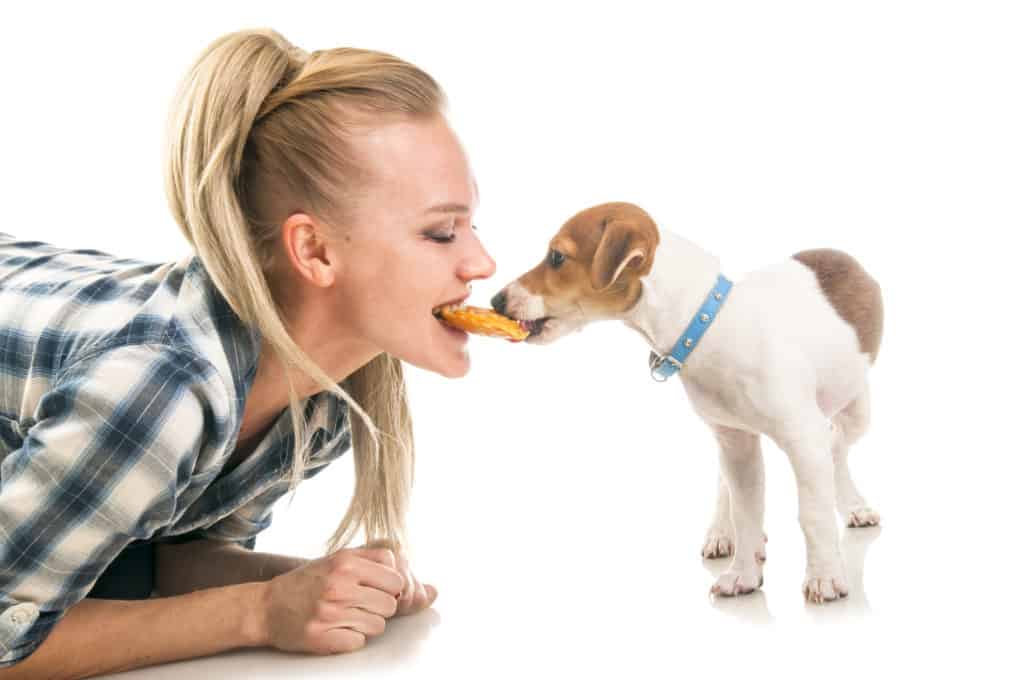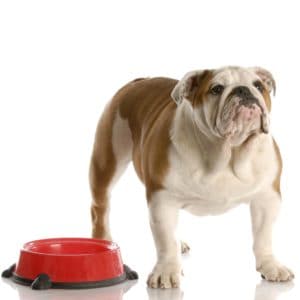 Wondering how much food to give a puppy? Well, first, congratulations on becoming a proud puppy parent!
Wondering how much food to give a puppy? Well, first, congratulations on becoming a proud puppy parent!
Choosing the right amount of food to serve your new fluffy companion is an important decision. Nobody wants to feed a puppy too little, but giving them too much can be just as unhealthy.
In this post, we’ll cover everything you need to know to help you make the right decision for your tiny (or not so tiny) four-legged friend.
What Is The Best Puppy Food, Exactly ?
Do you have more than one canine companion in your family? If so, and if this is your very first puppy, you may have wondered if it’s okay to feed grown-up food to your new pup. After all, what’s the difference?
There’s actually a big difference between the two, meaning that your little pet is much, much better off eating special puppy food.
Puppy Food vs Grown-Up Dog Food
The best puppy food is made to meet special standards that have been set by the Association of American Feed Control Officials (AAFCO). It differs from regular ‘Adult’ dog food because it is made to support growth. According to one RSPCA Vet, Dr. Leigh:
“It is important to ensure your dog’s food is both complete and balanced for its stage of life.” (Davidson, n.d.)
And for puppies, this means their food must provide them with certain crucial nutrients. These include:
- DHA – an Omega acid which your tiny pup once got from his mom, prior to being weaned. DHA is common in the best puppy foods as fish or salmon oil and helps your little one develop healthy eyes and stellar brain function.
- Calcium – small puppies are still trying to grow a strong skeleton. When you buy puppy food instead of regular adult food, they’ll be getting more of this. It’s a good thing!
- Protein – all dogs require this essential macronutrient, but puppies need much more than their grown-up counterparts. Think of protein as solid building bricks for your fluffy friend to create muscle!
- Fat – pups require energy from healthy forms of fat. Otherwise known as lipids, they rely on these for everything from play to exercise. And growing, of course!
How Much Food Should I Feed My Puppy?
Adult pooches have very distinct requirements from growing pups. While adults only need to maintain a healthy weight, puppies use more energy just to grow their bodies.
But while those puppy dog eyes may be really hard to resist, try to avoid piling up the chow!
There are two main things to keep in mind:
- Your puppy is going to need a certain number of calories every day — think of this as their recommended daily calorie intake.
- You’ll be serving this to them across several mealtimes — which will be only a fraction of what they eat each day. This determines the serving size that you give them.
If a puppy’s going to need 1,200 calories daily when he’s 12 weeks old, this should be spread out fairly evenly across his daily meals.
Puppy Weight Charts
Either way, you may still be wondering “How much food should I feed my puppy?”, or “What are his recommended daily calories?”
The truth is, these specifics will vary according to their stage of development. Usually, a quality puppy food manufacturer will specify rough amounts on the bag or can that you’re looking at. This is based on other factors, too, including their body mass, what breed they are, and how large their parents were when fully grown.
As one vet, Dr. Becker, says:
“Several factors will play into the amount of food you feed your puppy. They include the dog’s age, current weight, anticipated adult weight, her breed, the environment she’s in (including the climate), and her activity level.” (Becker, 2012)
One thing that’s the same for all puppies is that as they get older, they need fewer calories to grow than before. Here we’ve included some charts of the average adult weights for different canine breeds, so you can see how different body masses stack up.
Average Adult Body Mass: Giant Breeds
| Average Male (lb) | Average Female (lb) | |
| Great Dane | 140-175 | 110-140 |
| St Bernard | 140-180 | 120-140 |
| Mastiff | 160-230 | 120-170 |
| Irish Wolfhound | 120 | 105 |
| Leonberger | 110-170 | 90-140 |
Average Adult Body Mass: Large and Medium Breeds
| Average Male (lb) | Average Female (lb) | |
| Labrador Retriever | 65-80 | 55-70 |
| Irish Setter | 70 | 60 |
| German Shepherd | 65-90 | 50-70 |
| Collie | 60-75 | 50-65 |
| Boxer | 65-80 | 50-65 |
| Bulldogs | 50 | 40 |
| Siberian Husky | 45-60 | 35-50 |
| Siberian Husky | 45-60 | 35-50 |
| Golden Retriever | 65-75 | 55-65 |
Average Adult Body Mass: Small Breeds
| Average Male (lb) | Average Female (lb) | |
| Shih Tzu | 9-16 | 9-16 |
| Daschund | 16-32 | 16-32 |
| Chihuahua | <6 | <6 |
| Pomeranian | 3-7 | 3-7 |
| Yorkshire Terrier | 7 | 7 |
Source: AKC.org
How Often Should I Feed My Puppy?
 Does it seem like your little puppy is always hungry? We’ve been there! Fortunately, there’s a lot of expert advice on when, and how frequently, they really need to eat. Broadly, the younger your puppy, the more often they will need to be fed. Here are some examples.
Does it seem like your little puppy is always hungry? We’ve been there! Fortunately, there’s a lot of expert advice on when, and how frequently, they really need to eat. Broadly, the younger your puppy, the more often they will need to be fed. Here are some examples.
During The First 4-8 Weeks
During this period, your puppy is growing super-fast. This can also be an important time that requires extra care since your puppy has just been weaned off formula or milk. It’s a good idea to check with your vet whether you might need to free-feed your puppy with softened kibble throughout this time.
Between 8 weeks – 6 months
Usually, by the 2 month (8 week) mark, your puppy should be eating a minimum of three meals daily. Some smaller-breed puppies will need more frequent feedings. Occasionally, this could be as many as six meals per day.
Getting into a regular rhythm is a good thing, and be very helpful for training your dog. As well as this, you’ll be better able to anticipate when your puppy requires outdoor visits to the toilet!
Between 6 – 12 months
In general, how much food to feed a puppy at each meal will increase as they are fed less frequently. After six months, you can usually switch most breeds over to two daily feedings. This may not apply to small breeds, however, as these dogs often must be fed frequently for their whole lives.
After 6 months
Around the 1 year mark, most large dogs will be ready for adult dog food, though you should stick to two meals per day. Some giant breeds may take even longer, but there is rarely any need to drop down to one meal a day.
So, while they are adaptable little creatures, puppies generally shouldn’t eat too close to their bedtimes. Here’s one example timetable that you might find helpful.
| 5 Daily Mealtimes | 4 Daily Mealtimes | 3 Daily Mealtimes |
| 7 am | 7 am | 7 am |
| 9.30 am | — | — |
| 12 pm | 12 pm | 12 pm |
| 3 pm | 3 pm | — |
| 5 pm | 5 pm | 5 pm |
Toy Breeds Need To Eat More Frequently
The smaller the breed, the more important it is to make sure they have multiple meals throughout the day. Since toy breed dogs have a smaller stomach and limited amount of food they can take in at a time, this means they blow through their energy storage faster than a larger dog. When a puppy burns through their stored energy, this means their blood sugar can plummet.
A dangerous drop in blood sugar is referred to as hypoglycemia, and can be extremely dangerous if it’s not addressed quickly. In order to prevent a drop in blood sugar in your small breed puppy, it;s best to feed them a minimum of 4 times a day until they reach 6 months of age. This means you will break their recommended calories into 4 equal meals throughout the day.
Is The Best Puppy Food Wet Or Dry?
The best puppy food is always a healthy choice, from recognized manufacturers, and suitable for a puppy’s life stage and breed. Outside of this, it’s perfectly okay to feed your fluffy friend wet canned food, dry kibble, or some mix of the two.
“Mixing up wet and dry food can be an excellent way to give your puppy an exciting change at mealtimes”
There are many different types of both available, from fish or poultry to beef or lamb. We can even recommend ‘alternative’ flavors from novel proteins such as venison or bison for your puppy. What matters the most is that he or she is getting enough of the macro- and micro-nutrients that is necessary for growth.
Nonetheless, there are some other things you can use to make your decision:
| Wet | Dry | |
| Shelf Life (unopened) | Years | Around 1 year |
| Shelf Life (opened) | Approx. 3 days (fridge) | >6 weeks (cool, dark dry place) |
| Moisture Provided | Approx. 75% | 6-10% |
| Cost | More expensive | Cheaper |
Am I Overfeeding My Puppy?
 Deciding how much food to feed a puppy can seem like a lot of responsibility. After all, like tiny humans, they rely on us. So, how do you know if you’re doing everything right?
Deciding how much food to feed a puppy can seem like a lot of responsibility. After all, like tiny humans, they rely on us. So, how do you know if you’re doing everything right?
Is My Dog Overweight or Underweight?
The feeding guidelines on puppy food packages will only get you so far. It’s not possible for manufacturers to guess how much exercise your particular puppy gets, so you’ll need to keep an eye on him or her as well. One good way to do this is using what’s known as a Body Condition Score (BCS) Chart.
This system was developed by vets to help pet owners figure out whether their dogs may be over- or underweight. Most charts use a scale from 1 to 9 or similar, with one end representing a severely underweight dog. At the other end, they compare this against a highly obese dog. Otherwise, you can look at your own dog’s abdomen, ribs, waist, and bones to assess whether he or she may be eating too much or too little. If his or her bones are highly noticeable, he’s likely underweight. If they’re very hard to feel, and his tummy hangs down, your puppy may be overweight.
“If you’re unsure about whether your dog is over- or underweight, don’t be afraid to ask a vet.”
Risks of over- or underfeeding
Your puppy needs to maintain a healthy weight for several important reasons. You can take steps above and beyond picking out the right food by ensuring your best friend is getting enough exercise.
“Overweight and underweight puppies face a much higher risk of health complications than regular puppies.”
Overweight dogs can often:
- Experience breathing difficulties, such as excessive panting;
- Have trouble moving around, especially as they can become tired while exercising;
- Experience fat accumulation around their vital organs;
- Have higher blood pressure;
- Be more susceptible to diabetes; and
- Suffer digestive complications such as constipation.
Underweight dogs may frequently:
- Suffer from malnutrition and dietary deficiencies;
- Have deteriorating muscles;
- Experience heart difficulties; and
- Not have enough energy.
It’s important to take care that you as a dog owner are also looking out for your pup’s health. Regular exercise and healthy chow are super-critical!
Puppy And Dog Food Calculator
As long-time dog owners and puppy lovers, we understand that you signed up for a dog. Not a math class! It’s why we’ve developed our own dog food calculator which you can use to figure out what the recommended daily calorie intake is for your dog’s size.
The calculator we have created can be used for all shapes and sizes of dogs. Simply input your puppy’s body mass in either pounds or kilos, and select whether you have got a puppy or dog. Our calculator then figures out your dog’s Resting Energy Requirement (RER). It takes account of all the factors you’ve entered and will provide you with a rough estimate of how many daily calories he or she needs.
Divide this figure by the number of times that you plan to feed your puppy each day and you’ll have a rough approximation of how many calories he or she needs each mealtime!
Don’t Forget Water!
Hopefully, this post has covered a lot of the questions related to “How much food should I feed my puppy”. Please remember though, that your puppy is also going to need plenty of fresh water to stay hydrated and healthy. Make sure to always provide a bowl of clean water next to his or her food to avoid dehydration.
And of course, if you have any more questions, why not leave us a comment or get in touch?
Helpful Links
- https://www.akc.org/expert-advice/nutrition/breed-weight-chart/
- Becker, K. (2012). Why “Overgrowing” Your Large Breed Puppy is Dangerous. Retrieved from https://healthypets.mercola.com/sites/healthypets/archive/2012/04/09/slow-growth-diets-for-giant-breed-puppy.aspx Accessed 4 Mar 2019.
- Davidson, L. (n.d.). What should I feed my dog? Retrieved from https://www.rspcapetinsurance.org.au/pet-care/dog-care/what-should-feed-dog Accessed 4 Mar 2019.



We absolutely love your blog and find a lot of your post’s to be just
what I’m looking for.